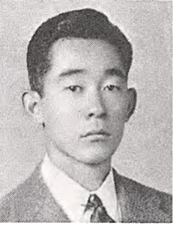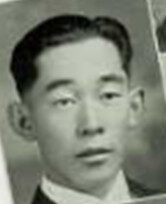Soldier Story: Tokio Fred Okamura
Soldier Story

Tokio Fred Okamura
Technician 4th Grade
442nd Regimental Combat Team
232nd Combat Engineer Company
Tokio Fred Okamura was born on March 22, 1919, in Los Angeles California, to Naoye and Hiro (Okamura) Okamura. There were five children in the Okamura family: Tokio Fred, sisters Yuriko and Hideko, and brothers Naohiko Henry and Toshio Thomas.
Naoye arrived in 1910 at the border crossing from Mexico to El Paso, Texas, at the age of 16 from the village of Yie, Kagoshima Prefecture, Japan. He had $17 in his pocket. Hiro arrived in April 1918 in Seattle, Washington, on the Africa Maru from Yie, Kagoshima Prefecture. Her destination was Los Angeles.

In 1920 the family was living at 2229 San Pedro Street in Los Angeles and Naoye was the owner of a grocery store. By 1930 they were living at 424 Park Street in El Centro and Naoye was still the proprietor of a grocery store. In 1937, Tokio graduated from Central Union High School in El Centro. Afterwards, he enrolled in Central Junior College.
Right: Fred’s senior class high school photo, 1937
By October 1940, Fred Tokio Okamura was enrolled at the University of California at Berkeley where he was a Chemistry major. He registered for the draft on October 16, Local Board No. 68 in Alameda County. His address was 2559 Le Conte Avenue in Berkeley. His point of contact was his father who lived at 424 Broadway Street in El Centro. Fred was 5’7½” tall and weighed 135 pounds. Written in pencil at the top of the registration card was “Until 1/15/41, 424 Broadway Street, El Centro.”
Fred was a member of the Japanese Students’ Club while at UC Berkeley. He graduated in 1941 (senior class photo above).
On August 16, 1941, he was listed in the Oakland Post-Inquirer among 25 local Oakland area youths who were called for induction in two days. He was from Local Board No. 68. The Oakland Post-Tribune of that same day reported that he was among five new draftees who were to be at the Draft Board office at Shattuck Avenue and Bancroft Way on August 18 at 7:30 a.m. for departure.
According to Army records, Fred Okamura enlisted in the U.S. Army on August 20, 1941, in Los Angeles. His home address was the one in El Centro. He had graduated from college and his civilian occupation was given as “Actor.”
Where Fred was sent in 1941 for basic training and where he served for the 18 months until the 442nd RCT was activated in February 1943 was not revealed in our research.
On May 21, 1942, his mother Hiro Okamura and her two sons Naohiko Henry and Toshio Tom of El Centro were incarcerated at the Colorado River WRA camp, also known as Poston, located in La Paz Country, southwestern Arizona. They entered directly rather than from a WCCA Assembly Center. A year later, on May 24, 1943, they were released to Crystal City, Texas, 115 miles southwest of San Antonio.
Fred Okamura likely arrived at Camp Shelby, Mississippi, between mid-April to May 10, 1943, which is the date that basic training began. After arrival he was assigned to the 232nd Combat Engineer Company, an original unit of the Combat Team. They trained next to the infantry and field artillery and learned the same things – the fundamentals of soldiering. But they were also learning to ply their specific trades. The engineers played dangerous games with high explosives, removing enemy roadblocks, and laying and destroying minefields. They learned how to operate their machines: metal detectors, chainsaws, and bulldozers. There were 204 enlisted men plus seven officers in the 232nd over the course of their service.
Basic training ended on August 23 and was followed by five days of intensive testing from Third Army teams. The RCT rated Excellent in physical fitness and Very Satisfactory in all other departments. Next followed a respite of short furloughs to enable men to visit cities such as New York, Chicago, or New Orleans, or to go west to visit their families in internment camp.
Platoon and company training began about October 20 and lasted about one month. This was followed by the final phase of training – combined training. Part of this time was spent by the 232nd Engineers demonstrating their abilities in support of the infantry. Several times the regimental commander called on the engineers to execute demolitions and then dig in as infantry to defend them so as to delay an enemy advance.
The entire Combat Team next participated in “D” Series maneuvers beginning on January 28, 1944, in the DeSoto National Forest, Mississippi. The 442nd and the 232nd were attached to the 69th Infantry Division for the maneuvers.
Finally, on April 22, 1944, the Combat Team departed Camp Shelby for Camp Patrick Henry, Virginia. On May 2, they sailed in a convoy of over 100 ships from Hampton Roads for the Theater of War, arriving at Naples, Italy, on May 28. The 232nd Combat Engineers sailed on the Liberty Ship S.S. Thomas Cresap along with the 442nd’s 206th Army Ground Forces Band. They were assigned to bunks in Hold No. 2. During the weeks at sea, the 206th Band entertained with concerts on deck and even in the below-deck quarters in inclement weather.
The 442nd entered combat near Suvereto, north of Rome, on June 26 in the Rome-Arno Campaign. They successfully pushed the enemy north along the western part of the peninsula. They remained in Italy until departing for southern France. The 232nd sailed on the U. S.S. Samuel Chase on September 26 and debarked at Marseilles on September 29.
After arriving in southern France, the Combat Team headed north and fought in the Rhineland-Vosges Campaign beginning on October 13. This was the most bitter fighting they had encountered. The 232nd Combat Engineers were attached to the 111th Engineer Combat Battalion of the 36th Infantry Division. They endured almost continuous rain and snow, and yet between October 23 to November 11 the men accomplished the engineering feat of constructing a supply road out of what was a mountain trail that rose 1,000 feet off the floor of the Laveline-Corcieux Valley of the Vosges Mountains. The road enabled supplies to be taken in and casualties to be carried out. This road led to the 36th Division outflanking the Germans and pursuing a disorganized enemy to the banks of the Meurthe River.
From October 26 to October 30, they participated in the famous rescue of the trapped “Lost” Battalion – the 1st Battalion of the 141st (Texas) Infantry Regiment – by sweeping the roadways for mines and keeping them clear for traffic. The 232nd Engineer Company was awarded a Distinguished Unit Citation for their actions in the Vosges Campaign.
Due to devastating casualties that put the 442nd below combat strength, they spent the months of late November 1944 through March 1945 in the Rhineland-Maritime Alps Campaign. This was a mostly defensive position to guard against enemy incursion along the French-Italian border. While in the south of France the men often had passes to visit Nice where they could relax. For this reason this was nicknamed the Champagne Campaign.
After rebuilding their numbers as replacement troops arrived to the 442nd from the US, the 232nd was sent with the 442nd RCT back to Italy to fight in the Po Valley Campaign. The 232nd Engineers debarked on March 23, 1945, on the LST 907 for Italy. The 442nd was engaged in combat from April 4 until the German forces in Italy surrendered on May 2. Once again, the 232nd Combat Engineers were awarded a Distinguished Unit Citation as part of the Combat Team for their part in breaking the enemy’s heretofore impregnable Gothic Line.
Our research did not reveal when Fred Okamura left Italy during the Occupation or when he was discharged from the U.S. Army.
For his military service, Technician 4th Grade Tokio Fred Okamura was awarded the: Good Conduct Medal, American Campaign Medal, European-African-Middle Eastern Campaign Medal with four bronze star devices, World War II Victory Medal, Army of Occupation Medal, and Distinguished Unit Badge. He was posthumously awarded the Congressional Gold Medal on October 5, 2010, along with the other veterans of the 442nd Regimental Combat Team. Conferred by the U.S. Congress, the award states: “The United States remains forever indebted to the bravery, valor, and dedication to country these men faced while fighting a 2-fronted battle of discrimination at home and fascism abroad. Their commitment and sacrifice demonstrates a highly uncommon and commendable sense of patriotism and honor.ˮ
Tokio Fred Okamura married Helen Hatsuko Nozawa (born June 27, 1922) on August 19, 1947, in California. She was born on June 27, 1922, in Los Angeles to Yoshitaro and Mura (Shida) Nozawa.
In 1950, the couple lived at 432½ East 3rd Street, in the Hotel Tokiwa, a boarding house in Los Angeles. With them were their son (age 1), Fred’s parents Naoye and Hiro, sister Hideko, and brothers Henry and Tom. Fred was employed as a junior chemist at an oil refinery. Naoye was the proprietor of a vegetable market and Henry was a bookkeeper in a retail store.
In 1955, Tokio was an organizing member of the Harbor City Koyasan Japanese Language Club. Ten years later, he was among the founding honorees at the 10th anniversary celebration. The family was living at 26203 Zephyr Avenue, Harbor City. Tokio was employed by Douglas Aircraft’s Missiles and Space Systems and Aircraft Groups.
In June 1961, Okamura attended the annual reunion of the 442nd Veterans Club in Honolulu. Unfortunately, someone entered his room at the Reef Hotel in the middle of the night. He awakened to find the thief fleeing with his wallet.
Tokio Fred Okamura died on April 19, 1970, in Los Angeles. According to family, he was buried at Evergreen Cemetery. He was survived by his wife, two sons, one daughter, his brothers Dr. Henry Okamura and Tom Okamura, sister Yuriko Okamura of Japan, and Mrs. Hideko Maruyama. His wife Helen died on February 21, 1992. She was survived by her children and six grandchildren. Her funeral was held on February 27 at the Koyasan Buddhist Temple, 342 East First Street, Los Angeles.
Researched and written by the Sons & Daughters of the 442nd RCT with assistance by the family in 2025.